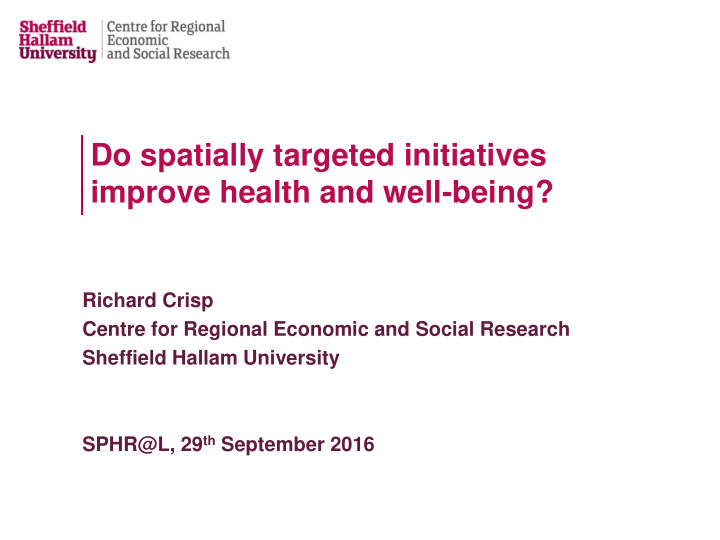



Do spatially targeted initiatives improve health and well-being? Richard Crisp Centre for Regional Economic and Social Research Sheffield Hallam University SPHR@L, 29 th September 2016
Outline • Relationship between poverty, place and heath • Policy context: a 'post-regeneration' era? • Findings from NDC and other ABIs • Reflections 2
Poverty, health and place • Link between poverty and health well- established (e.g. Pantazis et al , 2006) • Poverty can contribute to poor health (diet, housing + environment)... • ...and poor health can contribute to poverty (loss of income, cost of treatment) • Poverty and health inequalities have a spatial dimension 3
Poverty and life expectancy within neighbourhoods Source: Whyte (2016) 4
What are spatially targeted initiatives? • Regeneration = 'policy interventions seeking to achieve some combination of economic, physical, social and environmental improvements in defined geographical areas that have experienced decline' (Crisp et al., 2014) • ABIs = 'time limited programmes, designed to address either a particular issue, or combination of problems, impacting on pre-defined urban localities ' (Lawless, 2006). 5
Why target areas? • To address the compounding disadvantages of 'area effects'... • ...but challenged by notion of 'sorting effects'? • Other rationales come into play: – Targeting limited resources – Tackling negative features of areas – Improving effectiveness of services – Harnessing local knowledge 6
The shift to holistic regeneration • Area-based regeneration focused on physical + economic renewal in 1980s • Failure of 'trickle down' led to switch to more holistic approach: – City Challenge (1991) – Single Regeneration Budget Challenge Fund (1994) – New Deal for Communities (1998) – Neighbourhood Renewal Fund (2000) 7
Different approaches to tackling health inequalities People-based People and place- Place-based interventions: based interventions: interventions : Health Action NDC Housing Market Zones NRF Renewal Decent Homes 8
Regen spend by activity type (2009/10-2010/11) Regeneration Activity Type £m p.a. % of all annual core regeneration expenditure People-based interventions Community Development (volunteering, community 35 0.3 facilities, investment in community organisations, formal participation) Health (healthy living, smoking cessation, drug and alcohol 17 0.1 treatment, teenage pregnancy, supported living) Education (truancy, classroom assistants, raising 70 0.6 aspiration mentors, family learning support) Total share of budget on 'people-based' interventions 122 1 Place-based interventions Housing (New dwelling construction, demolition and new 6460 64 build, improving existing stock) Environmental (Open space/community space/nature 437 4.4 reserves, public realm, street and environmental cleanliness) Crime (neighbourhood wardens, community policing, 19 0.2 CCTV, partnership working) Total share of budget on 'place-based' interventions 6916 68.6 Adapted from Tyler (2013) 9
A 'post-regeneration' era? • Regeneration policy after 2010: – End of top-down ABIs (NDC, HMR) + strategies (NSNR) – Narrative of failure – New structures of sub-regional governance (LEPs, Combined Authorities, metro mayors) – Shift in emphasis from capital to revenue spend – Big society, localism + 'DIY' regeneration (Neighbourhood Planning, Community Rights) – No major programme or national strategy! 10
Our research 1. National Evaluation of New Deal for Communities http://extra.shu.ac.uk/ndc/ 2. Regeneration and poverty: policy and practice review http://www4.shu.ac.uk/research/cresr/ourexpertise/ area-regeneration-and-localisation-evidence-and- policy-review 3. Community led-approaches to reducing poverty in neighbourhoods http://www4.shu.ac.uk/research/cresr/ourexpertise/ community-led-approaches-tackling-poverty 11
The NDC approach to tackling health inequalities • NDC spend = £148m + £72m of leveraged funding (1999-2008) • Key priorities: – new/improved health facilities inc. extra staff – promoting healthier lifestyles – targeting vulnerable groups 12
Spend per capita low 13
NDC - improvements in absolute outcomes 14
Did NDCs areas narrow the gap with England? 15
The SF36 mental health score 16
Improvements relative to comparator areas 17
Longitudinal change • Longitudinal analysis (2002-06) shows that improved mental health scores associated with improvements in: – Fear of crime or being a victim of crime – Satisfaction with accommodation – Satisfaction with area – Social relations – Vertical trust – Employment status (not into work - in work) – General health • Mutually beneficial links across outcomes around crime, the environment, trust in local agencies, social relations, and mental health 18
Putting NDC into context • Targeting health inequalities through a dedicated programme ( Health Action Zones) had limited impact • But place-based regeneration schemes often report positive impacts on health and well-being: – Decent Homes = lower incidence of cardiovascular and respiratory complaints; a reduction in falls and accidents requiring medical attention, and fewer GP visits and hospital admissions ; improved satisfaction with home and neighbourhood + enhanced well-being amongst tenants – Housing Market Renewal Pathfinders = improved living conditions, enhanced health and higher feelings of safety due to better security and reduced incidence of crime 19
But regen doesn't always improve H&WB... 20
Can communities fill the gap? • Evidence that community-led activities have beneficial impacts on health and well-being: – Volunteering in disadvantaged n'hoods enhances well-being, social interaction and perceptions of area (e.g. Hickman et al., 2015) – Food banks improve well-being for users with mental health issues through social interaction (Garthwaite et al. , 2015) – Social groups to tackle report increased confidence + well- being work or education (Parsfield, et al., 2015) – Volunteers in Empty Homes Community Grants programme see increase in self-esteem (Mullins and Sacranie, 2014) • But evidence base poor, activities undermined by Austerity + difficult to achieve scale 21
Final reflections and implications • Spatially targeted initiatives have not dramatically reduced health inequalities.. • ..but still can improve aspects of health and well-being esp. mental health in relative terms • Limited evidence that dedicated health initiatives work best.. • ..but associations between MH + place-based improvements suggest value of holistic interventions • Policy developments a concern given that: – Devolution has seen a loss of focus on disadvantaged n'hoods – DIY regeneration + community-led activities unlikely to fill gaps • Engaging communities could redress democratic deficit of devolution + remind policymakers of needs + priorities • 'Inclusive growth' agenda may provide strategic focus 22
Recommend
More recommend